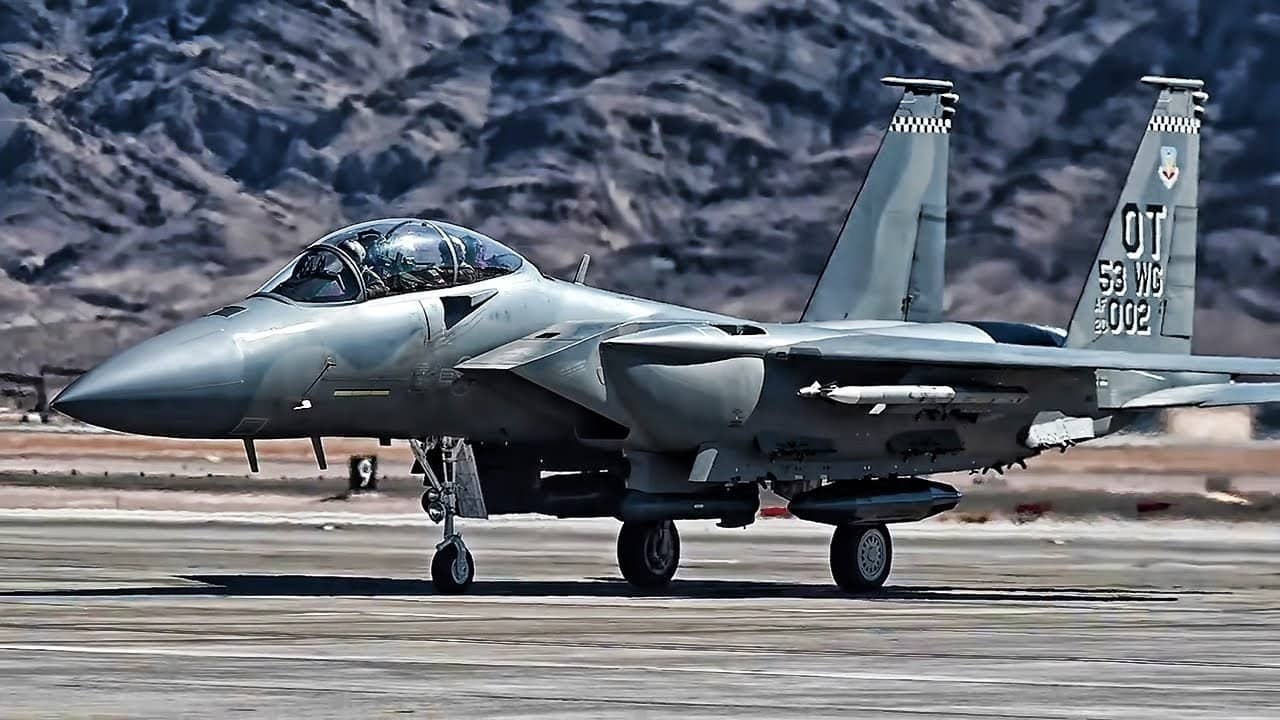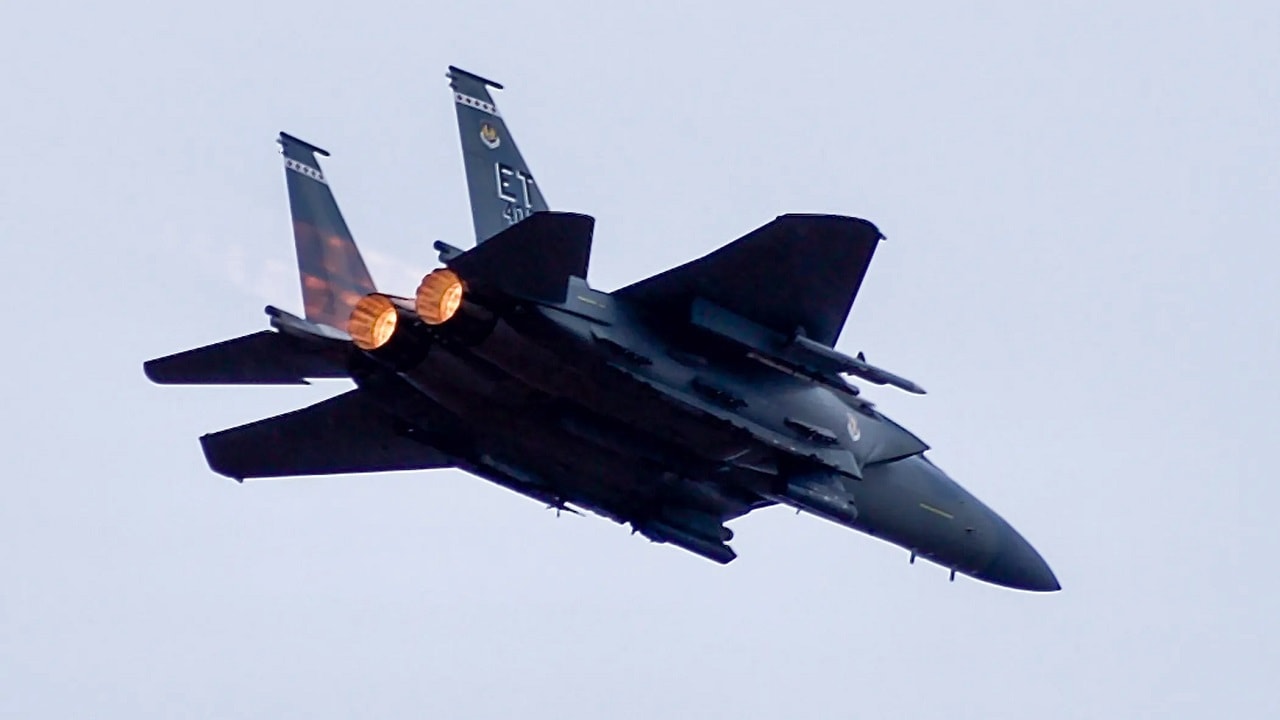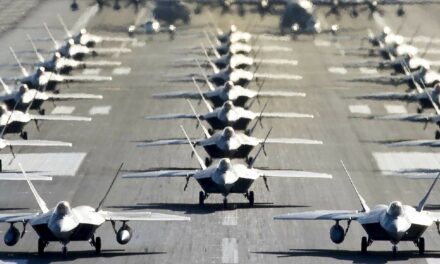We support our Publishers and Content Creators. You can view this story on their website by CLICKING HERE.
What You Need to Know: The McDonnell Douglas F-15 Eagle, originally designed to counter a Soviet MiG-25 threat, evolved into one of the most versatile and powerful fighter platforms in history. Known for its unmatched climb rates, maneuverability, and advanced avionics, the F-15 boasts a perfect air combat record of 104 wins with no losses.
-Over the decades, the F-15’s design has inspired experimental variants, including the Sea Eagle for aircraft carriers, the thrust-vectoring ACTIVE, and the stealthier Silent Eagle.
-Additionally, it was explored as a platform for hypersonic missile research and even a rocket launch vehicle. These innovations showcase the F-15’s enduring legacy as a game-changing aircraft.
Developed at the peak of the Cold War, the McDonnell Douglas F-15 Eagle was designed to compete against a Soviet fighter American military officials believed was all but unbeatable. America’s Defense apparatus looked at the record-breaking speed and power of the emerging MiG-25 and let their imaginations run wild, but the aircraft they designed to defeat this nightmare of their own creation was somehow even wilder.
When the F-15 as we now know it emerged from development, it came with an unprecedented combination of power, maneuverability, and advanced avionics that left it without equal anywhere in the world. Its powerful pair of Pratt & Whitney F100 afterburning turbofan engines could propel the Eagle from the ground to 30,000 feet in less than 60 seconds, and up to 65,000 feet — high enough to boil the blood of its pilot — in just over two minutes. In fact, a modified F-15, dubbed the Streak Eagle, broke eight climbing world records before the F-15 even entered service, reaching nearly 100,000 feet — 15,000 feet above the SR-71’s stated service ceiling — in about three and a half minutes.
But the Eagle is much more than a rocket ship with wings.
Through a combination of its immense power output and low wing loading (or the ratio of aircraft weight to total wing area), the Eagle is so nimble that Boeing test pilots have gone on record to say that the latest F-15EX, equipped with new fly-by-wire controls, can perform aerobatic maneuvers that are usually reserved for jets with thrust vectoring engines, or engine nozzles that can move independent of the airframe, found in super-maneuverable fighters like the F-22 or Russia’s Su-35.
Thanks to a constantly improving avionics suite and the addition of increasingly capable air-to-air missiles, F-15s may have been designed for close-quarters battles, but have evolved in BVR champs. In 2021, the US Air Force announced an F-15C scored the longest-ever reported air-to-air kill against a BQM-167 target drone — at a distance that has yet to be disclosed, but is understood to be in the triple digits.
With an unmatched air combat record of 104 wins and zero losses, Eagles have been known to make it home after taking missile damage to engines, and even after losing an entire wing in an air-to-air collision.
Within just three years of entering service, the Eagle proved so capable that McDonnell Douglas began work on an interdiction fighter/bomber based on the same airframe, ultimately resulting in the two-seat F-15E Strike Eagle — a platform that has not only earned its own acclaim as an air-to-ground fighter in combat, but holds the distinction of being the only aircraft in history to score an air-to-air kill with a laser-guided bomb.
But while the American F-15 lineage would grow to include the F-15E Strike Eagle in 1988 and the F-15EX Eagle II more recently, this broadly capable platform has been the basis for countless other cutting-edge efforts, some of which seem practically unreal. Here are just a few of them.
F-15N: THE SEA EAGLE
In the early 1970s, Grumman’s F-14 Tomcat, intended for duty aboard America’s aircraft carriers, was facing looming concerns about its size, weight, and complexity, prompting McDonnell Douglas to propose modifying their F-15 concept (in development for the Air Force at the time) for duty aboard the Navy’s flattops.
At a gross weight of 44,500 pounds, the F-15 was 16,500 pounds lighter than the Tomcat with a similar load. That’s the equivalent of an M198 howitzer with a fireteam of troops to run it. Because the F-15 had a relatively low weight-to-wing-area ratio, it was more maneuverable than the F-14, and its less problematic pair of Pratt & Whitney F100-PW-220 engines gave it a higher top speed, beating the Tomcat’s Mach 2.3 by a healthy 150 or so miles per hour.
But better than faster or more maneuverable in the minds of some lawmakers was its price. McDonnell Douglas was prepared to deliver F-15As to the Air Force at a sticker price of $28 million per aircraft (or about $227.5 million in 2024 dollars). High as that may seem, the larger and more complicated Tomcat rang in at $38 million per aircraft, or about $308 million today. That’s right… one F-14 at the time cost about the same as three F-35s today.
The F-15N concept swapped out the F-15A’s existing emergency tailhook with a larger reinforced one suitable for carrier operations and added heavier-duty landing gear and folding wings for easier stowage below deck. All told, the necessary modifications added only about 3,000 pounds to the aircraft, keeping the Eagle’s performance largely intact. But for all the speed, power, and cost savings the Sea Eagle could have offered… it fell well short of the F-14 in two areas that were vital for carrier defense: its radar and inability to carry as many hefty AIM-54 Phoenix missiles.
F-15 Aircraft #2 on Tarmac at Sunset with Weapons in Saudi Arabia. Image Credit: Boeing.

F-15EX Eagle II. Image Credit: Creative Commons.

F-15EX. Image Credit: Creative Commons.
The F-14’s massive AN/AWG-9 radar was the largest and most powerful ever affixed to a fighter until the emergence of the F-22 Raptor, and the system was purpose-built to be paired with the long-ranged Phoenix missile to take down Soviet bombers long before they could deploy anti-ship cruise missiles toward American carriers. The F-14, which was the largest American fighter ever to see carrier duty, could carry a half dozen of these massive missiles… whereas the F-15 could only carry one. With additional modifications to carry more AIM-54s, the newly dubbed F-15N-PHX weighed in at 10,000 pounds heavier than a standard Eagle, eliminating its performance advantage.
Ultimately, the Tomcat won out — but it’s still fun to think about how Top Gun would have been different with Maverick at the stick of a Sea Eagle.
F-15 ACTIVE: THE THRUST-VECTORING EAGLE WITH CANARDS
In 1984, the Flight Dynamics Laboratory out of the Air Force Aeronautical Systems Division awarded a contract to McDonnell Douglas to begin development on an F-15 concept that would allow Eagles to take off and land on short or damaged runways, based on the assumption that airstrips would be early targets in a conflict with the Soviet Union. Among the changes incorporated to this end were 2-directional thrust vector control similar to that later found in the F-22 Raptor, and the addition of canards made out of the horizontal tail surfaces of an F/A-18 Hornet.
The resulting F-15 STOL/MTD (Short Takeoff and Landing/Maneuver Technology Demonstrator) could take off at speeds as low as 42 miles per hour, and reduced the length of runway required for takeoff by 25 percent. To shorten landing requirements, the program leveraged reversible thrust from the aircraft’s engines in conjunction with its canards and TVC to reduce landing roll by a whopping 78%. While a standard F-15 Eagle needed more than 7,500 feet of clear runway to land, the F-15 STOL/MTD could do it in just 1,650.
In 1993, the Air Force handed the keys to their F-15 STOL/MTD to NASA for its new ACTIVE program, which was short for Advanced Control Technology for Integrated Vehicles. Building off of their previous digital flight control programs like HIDEC and Performance Seeking Control (PSC), NASA opted to retain the unusual wing layout of their new F-15 in the ACTIVE program, but added new Pratt & Whitney pitch-yaw balance beam nozzles (PYBBN) on a new set of engines; the F100-PW-229. Unlike its previous thrust vector control apparatus, these new nozzles offered a full 360-degree arc in which the nozzles could redirect outflow. As a result, NASA’s F-15 ACTIVE was the most acrobatically maneuverable Eagle ever to fly.
These programs were never meant to lead to a production design, and were instead all about gathering valuable information about different flight regimes and the effect TVC and canards could have on an aircraft’s performance. The F-15 used for these programs was ultimately retired in 2009.
F-15 GLOBAL STRIKE EAGLE: AN EAGLE WITH A ROCKET ON ITS BACK
In 2006, a team from Boeing proposed an incredible new use for America’s legendary F-15 Eagle that called for mounting a 45-foot rocket to its back. This rocket-carrying fighter would be given the seemingly logical (while still entirely dramatic) moniker of F-15 Global Strike Eagle, and it could have revolutionized how America deployed hypersonic weapons or put small payloads into orbit.
The idea was to use the Eagle’s powerful afterburning turbofan engines and the incredible amount of lift offered by its design to ferry rockets up to high speeds and altitudes before releasing them to ignite and fly the remainder of the journey into orbit. Launching orbital payloads from an aircraft would eliminate the need for expensive rocket launch facilities while making it possible for F-15s to rapidly deploy small payloads into orbit from anywhere on the planet with an airstrip and a hangar.
It was a relatively low-cost solution to a very expensive problem America’s military, particularly the Space Force, continues to tangle with today. But despite a very realistic approach to the Global Strike Eagle design, Boeing’s pitch likely still seemed a bit too crazy to put into practice… at least as far as we know.
Boeing’s approach called for the Global Strike Eagle to begin the launch process by pitching upward at a 40.4-degree angle and increasing speed to Mach 1.7 at an altitude of 27,700 feet. At 47,800 feet and a speed of Mach 1.35, the rocket launch vehicle would detach from the F-15 and give the fighter enough time (about four seconds) to pitch down and away before the first-stage rocket motor ignited.
The Global Strike Eagle would carry an SR-19 solid rocket engine sourced from the second stage of a Minuteman II ICBM on its back that, once released, would put out 60,300 pounds of thrust for 287.5 seconds, before its second-stage Orion 50XL rocket engine that would pump out 34,500 pounds of thrust for the next 289 seconds, and finally, a third stage Orion 38 rocket would produce 10,600 pounds of thrust for 289.6 more seconds — which would be enough to ferry a small payload into low earth obit.
From there, the rocket would do what rockets have long done best: burn through each successive stage until payload separation occurred in Low Earth Orbit approximately 400 seconds (an ominous 6.66 minutes) after the F-15 began the launch maneuver.
And because the platform could take-off and land like any other F-15 (with a 30,000-pound rocket strapped to its back, anyway), it would mean being able to deploy orbital payloads or even larger hypersonic weapons from existing airstrips all around the world. But, this Wile E. Coyote design didn’t catch the interest of the Defense Department (as far as we know).
F-15 SILENT EAGLE: IT AIN’T EASY BEING SNEAKY
Back in 2009, Boeing’s Silent Eagle aimed to make the world’s most prolific air superiority fighter into something more by injecting stealth into the F-15’s legendary DNA. The result may have been the most broadly capable F-15 the world had seen to that point, but delivered just in time to compete with what would become a foreign sales powerhouse, the F-35 Joint Strike Fighter.
Boeing recognized immediately that they had no hope of making the F-15 truly stealth. After all, we’re talking about an aircraft said to carry a 25 square-meter radar cross-section. That’s more than twice that of the B-1B Lancer heavy payload bomber and at least 25 times bigger than an F/A-18 Super Hornet. So to make their Silent Eagle concept work, Boeing had to do two things: bring the F-15’s radar return down dramatically, and convince potential buyers that stealth wasn’t the only important factor to consider when buying new fighters.
In March of 2009, Boeing unveiled their new fighter, or more appropriately, the newest iteration of the F-15E and subsequent F-15SA. Their New two-seat F-15SE Silent Eagle built upon the changes made for the Strike Eagle and its more recent Saudi Arabian export sibling, this time emphasizing a reduction in the fighter’s radar return alongside another round of avionics and system updates and upgrades.
The result was an F-15 that looked quite a bit like a stripped-down old one, but with some very important changes. Most notably, the 750-gallon conformal fuel tanks were removed from the fighter’s fuselage and replaced with new conformal weapons bays (CWBs) that were very similar in external design to the fuel tanks they replaced. This allowed the Silent Eagle to carry its firepower internally like 5th generation fighters, eliminating the radar return created by external munitions while maintaining a similar aerodynamic profile to the Strike Eagle that had already proven itself in service.
External missiles and fuel drop tanks were removed from the wings to further reduce the jet’s radar return. A BAE digital electronic warfare suite (DEWS) suite was added to supplement the aircraft’s stealth with jamming capabilities, alongside the Active Electronically Scanned Array radar, and an infrared search and track (IRST) sensor for both air-to-air and air-to-ground operations.
The other most notable structural difference between the Strike Eagle and Silent Eagle was in the tail. The F-15’s twin vertical tails played a big role in the aircraft’s large radar return, so the Silent Eagle’s tails were canted 15 degrees outward, thus reducing their radar signature while providing a slight boost to lift. That added lift, Boeing claimed, gave their new semi-stealth fighter an additional 75 to 100 miles of range, offsetting a bit of what was lost when swapping out the conformal fuel tanks.
The result was an F-15 with a substantially reduced radar cross-section and most of the air-combat prowess of its namesake — but at around $100 million per Silent Eagle ($145 million today), the Silent Eagle just wasn’t stealthy enough to compete with the likes of Lockheed Martin’s F-35 on the foreign market.
USING THE F-15 TO MAKE THE NAVY’S PHOENIX MISSILES HYPERSONIC
In the early 2000s, NASA came up with a plan to use the Air Force’s F-15 Eagle and the Navy’s famed AIM-54 Phoenix missile to slash the cost of experimenting with hypersonic flight. The effort wasn’t aimed at developing a new capability for America’s fleet of air superiority fighters, but rather at learning more about the unique challenges of flight at speeds over Mach 5, or the hypersonic barrier.
Because the Navy had a stockpile of decommissioned AIM-54 Phoenix missiles that already boasted a top speed of around Mach 4.3 (about 3,300 miles per hour), it seemed like the best possible candidate for hypersonic research. NASA assigned their Dryden Flight Research Center’s Thomas Jones to head the effort to pull another 500 miles per hour or so out of the missile, using NASA’s F-15B as a launch platform.
While the Navy was right that adding a 13-foot, 1,000-pound missile to the bottom of an F-15 compromised some of its maneuverability, the Eagle still had more than enough power to reach supersonic speeds with a Phoenix strapped to its belly. In the interest of cost savings, NASA reused as much of the Tomcat’s mounting hardware as possible, finally managing to squeeze a single Phoenix under the Eagle’s center line.
To be successful, Jones’ plan called for having the F-15 climb at speeds higher than Mach 2, or around 1,534 miles per hour with the Phoenix missile attached. Once it reached the appropriate speed and altitude, the missile would be released and have its solid-propellent rocket motor fire as its guidance system oriented the weapon’s nose down toward the ground at an angle designed for the highest attainable speed, rather than the fastest route to target.
By traveling at such high speeds, to begin with, and then firing its motor until it depleted all of its fuel, NASA believed the Phoenix missile would achieve hypersonic velocities before impact, allowing its suite of onboard sensors to gather much-needed data about the nature of flight at such high velocities, all for the cost of nothing more than a decommissioned missile the Navy had a stockpile of laying around.
But by 2006, the United States was looking for ways to cut costs associated with deterring near peers in favor of funding the ongoing Global War on Terror, and hypersonics were among the fields budgetarily left behind — ultimately ending the NASA effort before their Phoenix-carrying Eagle ever made it into the sky.
About the Author: Alex Hollings
Alex Hollings is the editor of the Sandboxx blog and a former U.S. Marine that writes about defense policy and technology. He lives with his wife and daughter in Georgia. This first appeared on Sandboxx.

 Conservative
Conservative  Search
Search Trending
Trending Current News
Current News 





